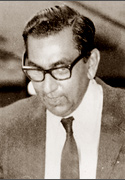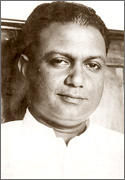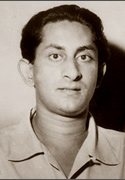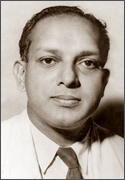The formation and break-up of the United Left Front
by W.T.A. Leslie FERNANDO
 |
 |
 |
 |
 |
 |
 |
|
Felix R. Dias |
Maithripala Senanayake |
Bala Tampoe |
Anil Munasinghe |
Cholomondely Gunawardena |
Dr. S.A. Wickremasinghe |
Edmund Samarakkody |
The 1962 Coup d'etat to overthrow the Government was fixed for
January 27, 1962 and it was uncovered by the Government on the day
before it was to be carried out. The Prime Minister Sirimavo
Bandaranaike along with Felix Dias Bandaranaike tackled it with boldness
and courage. A bout two dozen of the Security Forces and some civilians
were taken into custody. The Coup plan was entailed to arrest several in
the Government and Leftist leaders.
The social background of the Coup suspects were mostly Catholics from
the higher strata in society close to the Catholic church. At the
discussion of the committee stage of the Appropriation Bill 1960-61,
Philip Gunawardena warned about a secret conference of Army and Navy
officers where a leading Catholic priest too was present. It is said
that this plot gained momentum with the Schools Take-Over and was timed
for 1962.
The MEP hitherto least sympathetic to the Government offered it and
the people every assistance possible to get rid of the country finally
and totally from all conspiratorial elements. The CP also promised full
support to the Government to deal with reactionary elements. The LSSP
position however was ambiguous.
The LSSP condemned the Coup as a rightist plot emphasising that the
social background of the suspects were mostly Catholics from established
families, but interpreted that the Government has planed to arrest
working class leaders, but the Security Forces detailed for the purpose
had gone one step further and planned the detention of some members of
the Government. Dr. N.M. Perera implied this position in the House of
Representatives, Doric de Soza in the Senate and it was also mentioned
in the editorial notes of the "Young Socialists".
When the Government introduced a bill to set up a special court to
try the Coup suspects, the MEP and the CP voted with the Government. But
the LSSP voted against it with the UNP and the Federal Party. However
late Dr. N.M. Perera apologised to the Government for the allegation.
Why did the LSSP made such a serious charge against the SLFP Government?
Was someone in the LSSP close to the Catholic church?
Because of the misgivings about the Coup, the LSSP became isolated
from both the MEP and the CP for some time. Philip Gunawardena had way
back hinted about the Coup in the Parliament, when it was brewing. He
and the MEP supported the Government against the Coup and there
developed a close affinity between Philip and Felix R. Dias
Bandaranaike. There was a rumour at this time that Mrs. Bandaranaike,
Philip Gunawardena and Felix Dias Bandaranaike with some other Ministers
were trying to form a dictatorship on the advice of Ven. Henpitagedera
Gnanaseeha Thera. There were some reports of it in some journal.
The Government gained ground when the Coup was suppressed and filed
action against the suspects. Nevertheless soon after, the Government had
to face economic problems. In August 1962, when the Government wanted to
cut the rice subsidy by 50% it was opposed by the Leftists and even by
some Ministers in the Government. As a result, the Government was forced
to withdraw the proposal and Felix R. Dias Bandaranaike, the Minister of
Finance resigned.
When the Government was losing its popularity, there were moves for a
Left unity. At the annual conference of the MEP in December 1962, Philip
invited the LSSP and the CP for a United Left Front. Even before that
the three Leftist leaders Philip, Dr. N.M. and Dr. S.A. shared a common
platform to express their solidarity for people of Indonesia against
Dutch imperialism.
The move for the Left unity was strengthened when the LSSP, MEP and
the CP held joint rallies against the threats from America for
non-payments of full compensation for nationalised American oil
companies. By March 1963 there were discussions for Left unity and thy
decided to hold a joint May Day rally.
Parity of status
There were some dissensions in the LSSP for Left unity. The two big
plantation workers unions were not there among those who had organised
the joint rally. The Left wing of the LSSP alleged that the leadership
of the party changed the party policy to give parity of status to
Sinhala and Tamil to satisfy the partners of the alliance, especially
the MEP?
The joint May Day rally was a great show of unity and strength. The
problem of chairing it was solved by having a presidium of three leaders
Philip, N.M. and Dr. S.A. Wickremasinghe. Even the normal hostile press
to the Leftists admitted that it was the biggest rally ever held in Sri
Lanka. After the common May Day rally the three parties enthusiastically
moved for a United Left Front and a common programme was drawn on August
8, 1963.
On August 12, 1963 at the 10th anniversary of 'Hartal', the United
Left Front Agreement was signed with all solemnity. The policy of the
ULF as embodied in a 16 point program. Nationalisation of all foreign
owned estates and large ones owned by the locals, amending the Soulbury
Constitution, continuation of Sinhala as the State language, providing
the use of Tamil in Northern and Eastern provinces, granting citizenship
to Tamils of Indian origin permanently settled down in sri Lanka and
repatriating others were some of the highlights in the program.
The Left wing of the LSSP led by Edmund Samarakkody and Bala Tampoe
opposed the ULF. They accused that the ULF was formed to come into power
through Parliament betraying the revolutionary principles. They
maintained that the LSSP was embarking on popular frontism condemned by
Trotsky. However the ULF got the blessings of the Trotskyite
headquarters in Paris.
Nevertheless the ULF forged ahead and the three parties worked in
collaboration in the Parliament, in the trade union sector and in public
rallies. The joint trade union front of the ULF drew up a programme with
21 demands. At this time the MEP suggested that Philip Gunawardena who
was considered as a national figure should be made the leader of the
ULF. The CP too endorsed it, but the LSSP did not agree. Leslie
Gunawardena had remarked that whatever the attitude of the CP was,
making Philip the leader would have created a major split in the LSSP.
The ULF was gathering momentum as a powerful force. At the
bye-election for the Borella seat held on January 19, 1964, due to the
death of the sitting member Dr. W.D. de Silva of the SLFP, Vivienne
Gunawardena of the ULF won the seat defeating Dr. R.B. Lenora of the UNP,
who came second. The SLFP candidate, the wife of Dr. W.D. de Silva was
pushed to the third place. At the same time the strike planned by the
joint trade union front of the ULF made the SLFP Government uneasy.
At this stage the leadership of the SLFP sought an alliance with the
ULF or with the LSSP or the MEP. The 'Daily News' on March 17, 1964
reported that a Minister had met Dr. N.M. Perera to discuss the
possibility of some form of co-operation between the SLFP and the LSSP.
At a public rally on March 28, 1964 Prime Minister Sirimavo Bandaranaike
invited the Leftists to co-operate with the Government to carry forward
the fight against the reactionary forces. She also had individual
discussions with N.M. and Philip.
Atmosphere
Three days after the announcement of the Prime Minister the joint
central committee of the ULF issued a statement declaring "The ULF
stands ready to co-operate with the 'leftward' moving forces in the SLFP
for the purpose of mobilising resistance to the UNP led reaction for a
'leftward' solutions to the present crisis." In view of the changed
political atmosphere the ULF stalled the trade union action that was in
the making.
Although the MEP welcomed a joint Left-SLFP Government its leader
Philip demanded for such a unity and that C.P. de Silva and Maithripala
Senanayake should be expelled from the Government. Prime Minister
Sirimavo Bandaranaike was not at all agreeable to it. She was also
reluctant to admit the CP as some sections of the SLFP objected to
giving Cabinet positions to it.
Thereupon the secretaries of the three Left parties Leslie
Gunawardena (LSSP), K.D. Perera (MEP) and Pieter Keuneman (CP) sent a
letter signed by them to the Prime Minister dated June 4, 1964 stating
that a coalition was not possible along the lines Prime Minister
indicated, evidently a coalition between the SLFP and the LSSP. However
individually LSSP was to decide otherwise.
At the LSSP special conference held on June 6 and 7, 1964, there were
three factions. Edmund Samarakkody and Bala Tampoe faction took up the
position that the LSSP should not enter into a coalition with the SLFP.
Colvin, Leslie and Doric faction proposed that a government should be
formed between the SLFP and the ULF.
Dr. N.M. Perera and his group approved that a government should be
formed between the SLFP and the ULF, but if the negotiations failed they
proposed a coalition of the SLFP and the LSSP should be formed.
The resolution of Dr. N.M. Perera's group was adopted at the
conference. Within four days the LSSP became a partner in the Government
with Dr. N.M. Perera as the Minister of Finance, Anil Munasinghe,
Minister of Transport and Cholomondely Gunawardena, the Minister of
Public works.
That was the end of ULF! |

